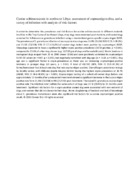| dc.description.abstract | In order to determine the prevalence and risk factors for canine echinococcosis in different endemic localities in the Tripoli area of northwest Libya, stray dogs were examined post-mortem, and owned dogs screened for Echinococcus granulosus infection using a standardised genus specific coproantigen ELISA. The prevalence of E. granulosus infection at necropsy in stray-dogs was 25.8% (15/58, 95% CI 15.3-39.0%), and 21.6% (72/334, 95% CI 17.3-26.4%) of owned dogs tested were positive by coproantigen ELISA. Sheepdogs appeared to have a significantly higher copro-positive prevalence (19/19 positive, p = 0.003), compared to 23.6% of other dog classes (e.g. 52/220 guard dogs and household pets). Worm burdens in necropsied dogs ranged from 29 to 2900 (mean 1064) and were positively correlated to coproantigen ELISA OD values (rs = 0.87, p < 0.001), but negatively correlated with dog age (rs = -0.69, p = 0.001). Dog age was a significant factor in copro-prevalence as there was an increasing coproantigen-positive tendency in younger dogs (≤5 years, p = 0.04). A total of 45/132 (34%, 95% CI 25.9-42.1%) of farms/homestead had at least one dog that was coproantigen positive. Overall copro-prevalence in dogs by locality varied, with Alkhums (Leptis-Magna) district having the highest copro-prevalence at 38.7% (24/62, 95% CI 26.6-50.8%) (p = 0.001). Coproantigen testing of a cohort of owned dogs before and approximately 15 months after praziquantel treatment showed a significant decrease in the coproantigen positive rate from 21.6% (72/334) to 9% (21/233) post-treatment. The overall E. granulosus coproantigen positive rate ('re-infection rate') within the same cohort of dogs was 22 % (10/45) by 15 months post-treatment. Significant risk factors for a copro-positive owned dog were associated with non-restraint of dogs, and owners that did not de-worm their dogs. Home slaughtering of livestock and lack of knowledge about E. granulosus transmission were also significant risk factors for a canine coproantigen positive result. © 2005 Elsevier B.V. All rights reserved. | en_US |

